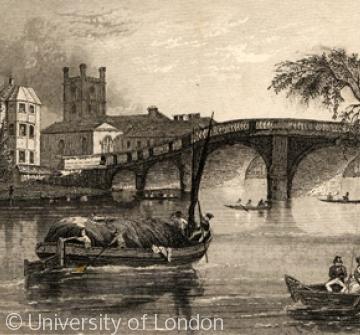Henley and the Thames River Trade

Image: an 'improved' Kennet or Thames and Severn canal-type barge at Henley bridge (engraving c.1834)
From the Middle Ages to the 19th century, Henley’s prosperity was underpinned by the Thames river trade. The Thames was a major transport route in the Anglo-Saxon period, and by the early 14th century Henley had emerged as one of the key inland ports in the country, funnelling grain from a wide hinterland into the expanding city of London, and channelling luxuries, fish and heavy goods in the opposite direction. Its primacy was cemented by growing navigation difficulties further upstream, which made Henley the highest point to which heavy commercial barge traffic passed on a regular basis. Beyond Henley goods travelled mostly by road, making it a major trans-shipment point at which goods were transferred from boat to wagon and vice versa. Much of the town’s medieval wealth was based on this trade, which until the Black Death was dominated by London-based merchants operating an a vast scale. The later medieval period saw the emergence of important Henley-based merchants, such as John Deven (active 1422–70), John Logge (active 1433–70s), and John Elmes (active 1417–60).
In the early 17th century commercial navigation to Oxford and beyond was re-established through the work of the Oxford-Burcot Commission, which cleared the river and built new poundlocks at Culham, Iffley and Sandford. This could have seriously undermined Henley’s position, but in fact expanding demand from London allowed Henley to continue as a major inland port, alongside upstream towns like Oxford, Abingdon, Wallingford and Reading. By the 16th century the capital's demand for malt had stimulated a local malting industry in Henley, and contemporaries emphasised the importance of the water-borne trade in malt, timber and grain. One was the London cartographer and bookseller Richard Blome, who in 1673 famously wrote that: Henley ... enjoyeth a considerable trade for malting; its inhabitants (which for the most part are bargemen or watermen) gain a good livelihood by transporting of malt, wood, and other goods to London, and in return bring such commodities as they and the inhabitants of the adjacent towns have need of, at easy rates: and its market, which is on Thursdays, is very considerable for corn, especially barley; which is brought them for their great malt-trade, there being oft-times in one day sold about 300 cart-load of barley. Daniel Defoe, the author of Robinson Crusoe, painted a similar picture, describing Henley's 'great business ... by the trade of malt and meal and timber for London', which was shipped on 'great barges ... as the other towns do'. Chilterns towns also benefited from the export of a 'vast quantity' of local beechwood, 'without which the city of London would be put to more difficulty than for anything of its kind in the nation'. During the 18th century Henley continued to participate in the still expanding Thames river trade. In 1767, over 56,000 tons of goods passed upstream above Marlow, of which nearly 9,000 (16%) were landed at Henley. Much of the trade continued earlier patterns, though by the 1780s trade in both directions was also becoming more varied. Freight shipped downriver by the Oxford bargemaster Thomas Court, for instance, included iron, copper, tin, manufactured metal goods, and bombshells, besides large numbers of cheeses sent to London from Lechlade. Upstream cargoes included groceries, a wide range of foreign imports (including timber), ashes and rags used as manure, and hides bound for Gloucester or Tewkesbury. Another important freight was coal, shipped down the coast and through London. By then barges were becoming massively larger, and navigation improvements were belatedly underway in the form of new poundlocks and a variety of canal schemes. The impact of the railways on the Thames river trade was marked and immediate, fulfilling fears expressed in 1834 when the Thames Commissioners asked the City of London 'what steps have been taken towards opposing that most useless and mischievous project the Great Western Railway'. The GWR line from London to Bristol was completed in 1841, and by 1849 toll income from river traffic below Staines had fallen by 50 per cent. Thereafter, the story of Thames barge traffic was one of gradual decline, balanced by a corresponding increase in the volume of pleasure craft. In Henley, Robert Webb & Sons still ran a weekly barge to London in the 1880s, and a handful of barge workers were recorded into the early 20th century. But by the 1890s the town's river trade was dominated by pleasure boats, many of them built locally by people like Tom Shepherd at the Red Lion, or Messrs Hobbs at the end of New Street. The development of the Regatta (established 1839) was part of the same pattern. Read more about the river trade, extracted from our forthcoming EPE paperback (see Assets opposite). Or find out about the riverfront (Thameside), locks and canals and Henley’s bargemen. .
Content generated during research for the paperback book 'Henley-on-Thames: Town, Trade and River' (ISBN 13 : 978-1-86077-554-3) for the England's Past for Everyone series


